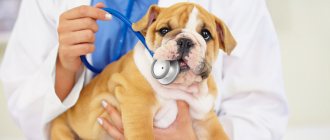Heat stroke in a dog is the result of prolonged overheating of the body. When exposed to external unfavorable factors, the animal’s thermoregulation, namely the process of adequate heat transfer, may be disrupted. The reason is the low rate of adaptation of the body to excess heat from the outside. The consequences of this condition are severe: a sharp disruption in the functioning of various organs and systems, a deterioration in the general state of health. If the dog is not provided with timely assistance, it may die from complications that develop.
The main provoking factors of overheating are high air temperature and inattention of the owner. If the animal is not provided with the opportunity to constantly cool its body, the risk of heat stroke is very high. Situations are especially dangerous when the dog is locked for a long time in a closed, unventilated space - a stuffy room, a car or a cramped carrier. From this article you will learn what the owner should do if his dog has suffered a heatstroke, as well as what is the treatment and prevention of this pathology.
Causes of heatstroke in dogs
This serious condition occurs when the animal overheats. Since dogs have weak thermoregulation, the body cannot cope with environmental factors. The fact is that dogs do not secrete sweat over the entire surface of their body to cool down. Unlike humans, their sweat glands are located only on their paws. If a dog is hot, it begins to breathe rapidly to cool down. At the same time, it opens its mouth wide and sticks out its tongue. However, this is not always enough, and as a result, the body temperature deviates from the norm. This happens if:
- The animal is exposed to direct UV rays for a long time.
- At high temperature and humidity environment.
- The risks increase in a stuffy, unventilated room or car.
- Excessive exercise in hot weather can also lead to hyperthermia.
- Shortage of drinking water.
Heatstroke in a dog: symptoms. Photo.
Sources
- Heat stroke in dogs: symptoms. ↗
- What are the signs of heat stroke in dogs and how can I prevent it? ↗
- The “Golden Hour” for Heatstroke Treatment. ↗
- Shapiro et al. Experimental heatstroke. A model in dogs. ↗
- How to Spot Heat Stroke in Dogs. ↗
- Bruchim et al. Heat stroke in dogs: A retrospective study of 54 cases (1999-2004) and analysis of risk factors for death. ↗
- 11 Symptoms of Heat Exhaustion in Dogs. ↗
- Heat Stroke in Dogs is Worse Than You Think. Here's What You Need to Know. ↗
- How to Treat Heat Stroke in Dogs. ↗
- Critical conditions in animals: algorithm of actions. ↗
- Heatstroke in dogs. ↗
- Heat Stroke and Heat Exhaustion in Dogs. ↗
- Keep Pets Safe in the Heat. ↗
- Hypothermia and hyperthermia. Magazine Veterinary Petersburg. No. 1-2016. ↗
Back to contents
Risk factors
All breeds suffer from hyperthermia. However, dogs endure heat worst of all:
- Northern origin, adapted to frost and winds. For example, Siberian husky, husky.
- With long hair. For example, collie, chow-chow, Newfoundland.
- With a thick dense undercoat. For example, Labrador, Golden Retriever.
- With a flattened, shortened muzzle because they have difficulty breathing in hot weather. (Brachycephalic breeds. For example, pug, bulldog, Pekingese).
- With dark color.
- Obese people.
- Bitches expecting a litter or after giving birth.
- Older dogs or puppies.
- With chronic diseases. For example, with pathology of the heart or lungs, increased levels of thyroid hormones.
How does heatstroke manifest in a dog?
The first signs of heat stroke can be easily confused with symptoms of other diseases. However, if you know that the dog was in the sun or in a stuffy room, then the cause of the illness is most likely overheating.
With moderate hyperthermia appears;
- lethargy and weakness;
- labored breathing;
- redness of the mucous membrane of the eyes;
- increase in body temperature to 39.5-40.5°C;
- increased heart rate (90+);
- loss of appetite;
- mouth open, tongue protruding;
- saliva flows profusely;
- the gaze becomes wild or clouded.
- The dog takes unusual positions on its stomach.
- The dog reacts slowly to your approach to it. Turns away or leaves.
Signs of severe hyperthermia:
- trembling in the body;
- dyspnea;
- nausea and vomiting;
- diarrhea;
- uneven breathing;
- mucous membranes and tongue turn blue;
- impaired coordination of movements;
- loss of orientation in space;
- body temperature above 40.5-43°C;
- increased heart rate (140+);
- acute renal failure;
- heart rhythm disturbance;
- dizziness;
- convulsions;
- loss of consciousness;
- state of shock;
- coma.
- heart failure.
If your dog's mucous membranes turn blue, immediate hospitalization is required. Photo.
Folk remedies
“Grandma’s recipes” can also have an effect on sunburn. These are sour cream, milk, kefir, egg white. These products contain proteins that prevent moisture loss and restore skin.
Important! Traditional medicines will really be effective if used at least twice a day. But, no matter what method is chosen to eliminate sunburn, it is imperative to moisturize the skin afterwards.
In terms of choosing creams, preference should be given to those containing hyaluronic acid, cactus extracts, aloe, sea buckthorn, green tea, and rosemary. Medical aerosols against sunburn and after-sun preparations do a good job of doing this.
If your child gets a sunburn
If you find that your child has sunburn, you should prepare a cold bath for him. Bathing in a bath with oatmeal gives a good effect. To do this, you need to take regular oatmeal, pour it into a cloth bag, tie it with thread and put it in the bath or hang it under the shower. The child should stay in such a bath for 5–15 minutes, after which he should be gently blotted with a towel so that a small layer of oatmeal powder remains on the skin. This will help relieve itching and soften the skin.
It is necessary that the child receives a sufficient amount of fluid. On the day of the burn and the next three days, the child should drink a lot of water. For damaged skin of a child, the general remedies described above are suitable.
Another important point is the child’s nutrition. Vitamin C can strengthen the immune system and also have a slight anti-inflammatory effect. It is better to give preference to varieties with bioflavonoids. The dosage for a child depends on his age, multiplied by 50 milligrams. The medicine is given twice a day, but if diarrhea begins, the dose should be reduced.
It is advisable to use liquid or powdered (non-acidic) vitamin C. These solutions are suitable for children and infants and can be used by adding to juice. Zinc will help strengthen the immune system and speed up skin regeneration. The dose for children under 2 years old is 5 milligrams, over two years old - 10–15 milligrams. The drug is given for two weeks, after which the course ends.
The carotenoid complex is given prophylactically. Carotenoids often help absorb sunlight and protect the skin from damage. Given with a multivitamin complex.
Important! When your child's skin becomes blistered and the temperature cannot be brought down, you should immediately consult a doctor.
When treating sunburn, proper diet is important. It is advisable to include fresh fruits and vegetables in your diet, as they contain large amounts of vitamins E and C, and without them, skin healing and regeneration will slow down. If for some reason it is not possible to consume fresh fruits and vegetables, care should be taken to take synthesized vitamins. They are present on the shelves of almost all pharmacies. There you can select a pharmacological drug based on the active ingredient ibuprofen. Timely intake of ibuprofen will relieve the skin inflammatory reaction, normalize the temperature of the human body, and significantly reduce the intensity of pain.
Heat stroke in a dog: first aid
You can and should provide first aid to an injured dog yourself. It consists of cooling the pet.
- First of all, you need to move the dog to a cool place. Don't force her to go on her own. If you are on the street, then provide help on the spot. Place your dog in the shade. A puddle or pond works well. If you are in the forest, you can remove peat or moss. Remove her muzzle and collar to free her breathing.
- Only when the dog feels better can you begin to slowly move towards the house. Stop often to give your dog a rest.
- A room with tiled floors or air conditioning is suitable. If there is no air conditioning, you can cover your pet with a damp, cool towel. The fan cools well and increases air movement. But it must be turned off periodically (every 10 minutes) to prevent hypothermia. Place something under your head to lift it slightly.
- Let your dog drink cool, clean water, but in reasonable quantities. The dog should drink a little on its own, without violence. If your dog refuses to drink (such as convulsions or loss of consciousness), wet his gums and tongue. Do not pour water into the mouth, as water may enter the lungs.
- Wipe your head, armpits, thighs and paws with cool water. A compress with small ice cubes (or frozen food from the freezer) on these areas of the body helps. However, remember not to over-cool the animal by covering it with ice on all sides. Ice should be applied to the places where the main blood vessels pass. For example, to the neck, armpits and groin.
- Wet the undercoat and skin well with cool water. You can then wrap your body in a damp towel.
- You can wipe the inner thighs and armpits with an alcohol solution. Also treat the paw pads and ears. This will help reduce the temperature.
- It is good to comb out the undercoat, even if the dog is not shedding at the moment.
- Make sure your body temperature drops smoothly. In other words, don't cool your dog down too much. The process should take at least an hour. Therefore, measure your body temperature every 10 minutes by inserting an electronic thermometer rectally.
Note! You should not completely bathe your dog in cold water. This can lead to irreparable health consequences. Because a sharp change in temperature leads to spasm of blood vessels and heart complications.
Beware of chills, as this is a sign of hypothermia.
Popular drugs
PanthenolSpray effectively relieves skin inflammation. The product contains dexpanthenol, and therefore has an anti-inflammatory and healing effect. Experts noted an obstacle to the development of inflammation when using the drug, rapid elimination of burning, redness and other unpleasant signs of a burn. PanthenolSpray is an original medicinal product that has been tested over the years and has gained wide popularity. Pharmacies offer many analogues with similar packaging.
If chills are observed and the general condition is disturbed, non-steroidal anti-inflammatory drugs are used - Ibuprofen, Paracetamol. You can also use aspirin, a drug from the salicylates group.
To prevent skin dehydration, experts recommend creams based on chamomile and calendula extract, Aloe Vera, and vitamin E. The components will help the skin absorb moisture and retain it for a long time.
Important! Treatment of sunburn does not allow the use of alcohol-containing lotions and other cosmetics, since they further dry the skin and cause additional injury. In addition, when washing burnt skin, you should not use soap, or overload it with too greasy creams.
Important! When blisters appear, it is absolutely unacceptable to pierce them.
3. Pain relief. Paracetamol, Aspirin, Acetaminophen and Ibuprofen help to cope with pain. Itching and burning are reduced by antihistamines. Aspirin in combination with ibuprofen inhibits the formation of toxic substances that cause swelling and redness of the skin. A regular cool bath helps reduce fever and pain. Symptoms of burning are caused by active blood flow, which is caused by severe inflammation, and cold water constricts blood vessels and alleviates the condition. But you can’t rush to get into the shower - these are the same microtraumas, unnecessary pain.
Heat stroke in a dog: treatment
If you notice signs of heatstroke in your dog, you need to take him to the clinic. Even if, in your opinion, everything has already returned to normal. Complications may appear after a few days. The doctor must examine the dog. If necessary, he will prescribe additional studies.
If the dog is showing signs of severe hyperthermia, the doctor will admit the dog to the NICU. Schedule an examination by specialized specialists. For example, a nephrologist, cardiologist, neurologist.
Be prepared to undergo testing. For example, ultrasound, ECG, thermometry, auscultation.
If there is a threat to life due to dehydration, infusion therapy is prescribed. Treatment will help replenish lost fluid. A dog with severe shortness of breath is placed in an oxygen box. There the optimal humidity and temperature for recovery will be set.
Diagnosis of the disease
With laryngeal injuries, you should seek emergency medical help as soon as possible. External examination and palpation are carried out by an otolaryngologist. If the patient's condition allows, instrumental examinations are performed: laryngoscopy - examination of the larynx using a laryngoscope or endoscopic examination. Additional diagnostics may include various diagnostic studies - ultrasound, MRI, CT, radiography of the neck, spine, respiratory function tests, etc. After the removal of dangerous critical symptoms or in the presence of minor injuries, an examination of the vocal cords is performed.
Consequences of heat stroke in a dog
Heat and sunstroke in dogs can lead to damage to internal organs and systems. For example, to:
- cerebral edema;
- blood clotting disorder (DIC syndrome);
- platelet growth and its consequences;
- renal dysfunction;
- damage to the cardiovascular system (arrhythmias, tachycardia);
- development of gasteroenteritis;
- diseases of the pulmonary system.
- hemorrhagic shock;
- multiple organ failure.
In such cases, treatment is aimed at eliminating the resulting pathologies.
Types of laryngeal injuries
External damage to the larynx occurs as a result of blunt trauma to the larynx, which occurs after strangulation, blow with a blunt object, fist or piercing object, car accident, etc. Blunt trauma can very often be combined, i.e. complicated by fractures of the cartilages that make up the larynx and ruptures of the vocal cords, tendons, and severe bleeding.
The cause of internal damage can be various medical manipulations on the organ, this is especially often caused by tracheal intubation, endoscopic examination of the bronchi and lungs, connection to a ventilator, etc. The organ can be injured by a foreign body with sharp and cutting edges that enters the larynx. Damage to the inner lining of not only the larynx, but also other parts of the respiratory system, can cause inhalation of toxic gases or too hot air. Severe coughing and screaming can also cause internal damage to the organ. Laryngeal injuries are divided into domestic, industrial and military.
Caution: What not to do if your dog has heatstroke
Contraindicated:
- Water your pet with ice water or apply ice generously over the entire body. Such actions can cause a spasm and, accordingly, lead to a blockage of the peripheral circulatory system.
- Water with water from above, as this will keep the undercoat dry. This creates a “greenhouse effect”. Since a wet layer of wool forms a shell, disrupting heat transfer.
- Inject steroids or NSAIDs.
- Use medications for the heart. Such as, for example, sulfocamphocaine. Because it can lead to tachycardia or arrhythmia.
- Forcefully pour water into the mouth if the dog is unconscious.











